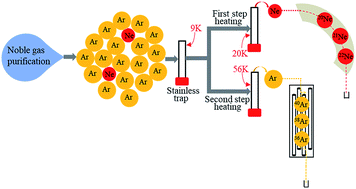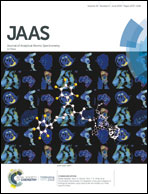Ne and Ar isotope analysis of samples with high abundance ratios of Ar/Ne and low abundance of Ne by MMS and QMS
Abstract
Analysis of isotopes of neon and argon using the same mass spectrometer is somewhat difficult because the 40Ar background after argon measurement can interfere with the 20Ne determination due to the very similar mass-to-charge ratios of 40Ar++ and 20Ne+. Analysis becomes even more difficult if the sample has a high abundance ratio of Ar/Ne and an extremely low amount of Ne. Here, we present a method for precise measurement of neon isotopes on a noble gas mass spectrometer (MMS) and argon isotopes on a quadruple mass spectrometer (QMS). The desorption curves of neon and argon on a charcoal trap and stainless steel trap were respectively determined, and the results demonstrated that the stainless steel trap was more suitable for the absolute separation of neon and argon despite requiring a lower temperature. The argon background effect of the MMS on the 20Ne determination was discussed emphatically; it was found that the charcoal trap immersed in liquid nitrogen (LN) near the ion source could effectively decrease the argon background. Furthermore, the liquid level of the LN should not only be located as close to the ion source as possible but should be kept constant, which is very important for the measurement of 20Ne with a small signal size. The ratio of CO2++/CO+ for MMS was 1.2 ± 0.3%, which enabled the correction of CO2++ interference in the 22Ne determination. An artificial mixture of standard gases with an abundance ratio of argon to neon as high as 1000 was prepared. 0.1 cm3 standard gas mixture with 5.50 × 10−13 mol argon and 5.53 × 10−16 mol neon was measured each time. The precisions of the isotopic ratios of neon measured by MMS were ±0.15% for 20Ne/22Ne and ±1.6% for 21Ne/22Ne. The precisions of the isotopic ratios of argon measured by QMS were ±0.5% for 40Ar/36Ar and 4.0% for 38Ar/36Ar. Although the precision of the argon isotope analysis obtained by QMS was not as good as that obtained by MMS, it fully meets the requirements for application in geochemical tracers. Moreover, this method avoids the use of the same mass spectrometer for analysis of both argon and neon, thus guaranteeing precision of the neon isotope measurements.



 Please wait while we load your content...
Please wait while we load your content...